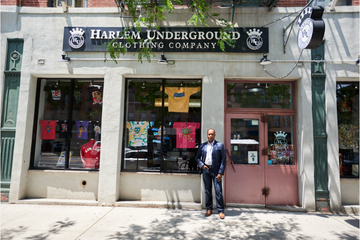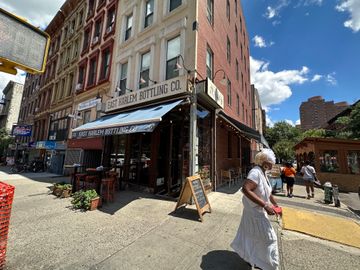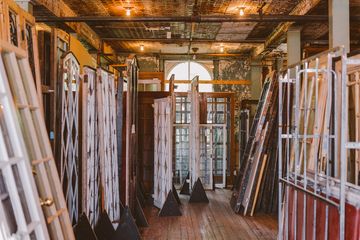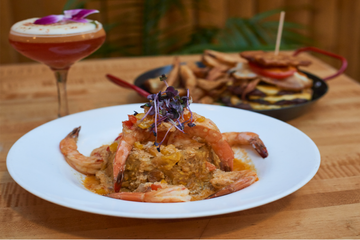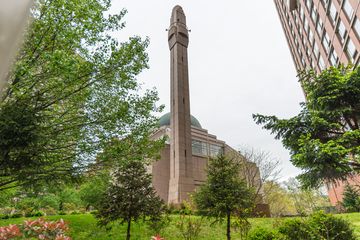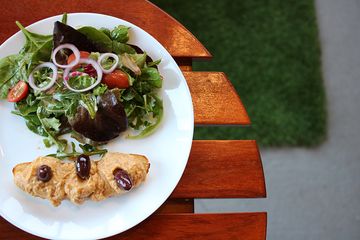UCG eats, originally named Urban Garden Cafe, has moved from 118th Street to 104th Street. The space on the corner of Park Avenue and 118th Street was a big white empty box when the Gatanas family first looked inside. It was Dimitri, the eldest son, however, who immediately had a vision, and wow did he make it come to life, literally, towards the end of 2016. The place had been empty for two years, but Dimitri had never paid much attention to it. After a fire happened in their Garden Center, a block away, Dimitri felt that a "shining star appeared, " and told him that he needed to take this, and make it his own by opening up a coffee shop - filled with plants. In addition to the family's history with plants, Dimitri has his own personal passion for collecting. As far as I could tell, Urban Garden Cafe will always be a work in progress, as Dimitri and his wife, Sarah, continue to travel and bring items back to their coffee shop. With one wall painted by a local graffiti artist, and the garden theme carried throughout, every nook is filled with antique and bistro tables, church pews, a parking meter, a seat "taken" from a commercial airplane, miniature chairs from India for young ones to sit on, and an array of colorful items used as both decoration and for sale. Pointing down at the cement floor and then over to the grass mats, Dimitri described UGC as "Urban culture meet nature, and then laughing he added, "hoarder meets a picker. "Sarah then joined us and spoke humorously about their travels. I love how they are able to share their passion for traveling and discovering. One of their excursions took them to Kentucky because Dimitri had read that they have great flea markets there. Little did he know that he would have to send a truck out to pick up all that they had purchased, including the front of a bus, which is now in the cafe. Completely entertained, I could have sat for hours more listening to the couple reminisce about their adventures. "I have encountered many eccentric, neat guys who have accumulated things over the years, " and apparently Dimitri is the perfect person to take them off their hands when they are ready to give them up. The menu pairs well with the plant based theme and the relaxed environment that has been created. It has inspired the food that is served. Due to their love of nature, the family decided to offer meatless options, more like a Mediterranean diet, which makes perfect sense, as it reflects their Greek background. "I love that I can continue our family traditions in a modern way. "On my first visit I had a "Pan de mie con queso" - a mix of Greek gruyere and fontina - "We are giving the Italians a bit of love" - the sandwich was simply done in a panini made on a thick slice of fresh brioche with tomatoes and pepperoncinis. Gooey and maybe the best classic grilled cheese sandwich possible, and it was served on a perfectly dressed mix of lettuce leaves. When I inquired about the coffee, Dimitri chuckled. We use beans roasted in New York, and the guys from the company were kind enough to teach us the business. He admitted, "we knew nothing about making a good cup of coffee and certainly had no idea how to make the leaves or hearts on top of a cup of cappuccino. " I can attest, however, that they have now mastered both. In addition to the sandwiches and salads that are served, the shop is like a mini gourmet market filled with interesting healthy snacks, oils, vinegars, wild flower honey, Greek cheeses and yogurt, oatmeal, hot sauce, dark chocolate toffees, Greek gum and Greek mountain tea. It is not just about a cup of coffee at Urban Garden Cafe, however, there is so much to discover, one needs to spend days to absorb it all. More importantly, though is to be sure to strike up a conversation with Dimitri, his brother Alex, his mom, dad or his wife, Sarah to understand the commitment, the passion and the love that they each feel for their latest project - and each other. "Passion at its absolute finest, " is how Dimitri phrased it. "We are having fun and that is the most important part. We are not pretentious, we are just providing for the community every way we can imagine... I trust this community and I am very proud of it... and I am only trying to transmit positive vibes. "Dimitri shared that he does not believe that the garden center, across the street, will last forever, so it is a good idea to extend the family business in a way that exudes the spirit of the neighborhood today. He prides himself in supporting some of the local artists, and he has even begun a community compost project. "I want to preserve the history by reclaiming items - serve good food to the world, and allow people to come and relax in a welcoming environment. Continuing, "I am not just saying it, we are really intertwined with the neighborhood. " Dimitri then reminded me of the story he had told me when I visited the Garden Center a few weeks before. "It is ironic that my grandmother is standing on a rooftop garden in the first page of the book, "Images of America - East Harlem Revisited. " She is on 117th Street. "We survived through some hard times but I always went back to my grandparent's roots and knew we could make it. He ended by saying, "I embrace all the things my grandma told me to do. I started walking and never knew what I was going to find.... and here I am. "When I tried to describe the setting of UGC to my husband after I returned from my lengthy visit, I realized that I could never do it justice. Therefore, a few days later, I found myself back on 118th Street with my husband in tow. This time it was on a snowy Saturday afternoon. The vibe was slightly different in that there were more people coming and going, rather than those that were nestled in their corner space reading and working during the week. Although I did spy one gentleman with the New York Times spread out before him, sipping on coffee and looking like he was settled in for the remainder of the afternoon. People commented to me that there just is not another place like this in the neighborhood. Everyone seems to have instantly gravitated towards UGC, and they are so appreciative of having a spot like this to purchase a good cup of coffee, something light to eat, and the pleasure of enjoying a conversation with others in their community.
